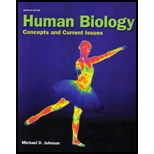
Human Biology: Concepts and Current Issues
7th Edition
ISBN: 9780321821652
Author: Michael D. Johnson
Publisher: Benjamin Cummings
expand_more
expand_more
format_list_bulleted
Question
Chapter 13, Problem 4AWK
Summary Introduction
To review:
The reason why the negative feedback loop is unable to prevent muscle contractions and pain during labor in a pregnant woman.
Introduction:
A pregnant woman may enter labor in the last week of gestation, which leads to the birth of the child. A series of events occur during the labor, which includes intense muscle contractions. These muscle contractions force the fetus from the uterus to the outside through the birth canal. The muscle contractions are extremely intense and painful.
Expert Solution & Answer
Want to see the full answer?
Check out a sample textbook solution
Students have asked these similar questions
Limetown S1E4 Transcript: E
n 2025SP-BIO-111-PSNT1: Natu
X
Natural Selection in insects
X
+
newconnect.mheducation.com/student/todo
CA
NATURAL SELECTION NATURAL SELECTION IN INSECTS (HARDY-WEINBERG LAW)
INTRODUCTION
LABORATORY SIMULATION
A Lab Data
Is this the correct allele frequency?
Is this the correct genotype frequency?
Is this the correct phenotype frequency?
Total
1000
Phenotype Frequency
Typica
Carbonaria
Allele Frequency
9
P
635
823
968
1118
1435
Color
Initial Frequency
Light
0.25
Dark
0.75
Frequency Gs
0.02
Allele
Initial Allele Frequency
Gs Allele Frequency
d
0.50
0
D
0.50
0
Genotype Frequency
Moths
Genotype
Color
Moths
Released
Initial
Frequency
Frequency G5
Number of
Moths Gs
NC
- X
Which of the following is not a sequence-specific DNA binding protein?
1. the catabolite-activated protein
2. the trp repressor protein
3. the flowering locus C protein
4. the flowering locus D protein
5. GAL4
6. all of the above are sequence-specific DNA binding proteins
Which of the following is not a DNA binding protein?
1. the lac repressor protein
2. the catabolite activated protein
3. the trp repressor protein
4. the flowering locus C protein
5. the flowering locus D protein
6. GAL4
7. all of the above are DNA binding proteins
Chapter 13 Solutions
Human Biology: Concepts and Current Issues
Ch. 13 - Would you be in favor of a federal ban on BPA from...Ch. 13 - Prob. 2QCCh. 13 - List the functions of the six hormones secreted by...Ch. 13 - Prob. 2CRCh. 13 - Prob. 3CRCh. 13 -
4. Define when you would call a norepinephrine a...Ch. 13 - Explain why a 30-year-old short person cannot be...Ch. 13 - Describe the function of the two hormones from the...Ch. 13 - Prob. 7CRCh. 13 - Prob. 8CR
Ch. 13 - Prob. 9CRCh. 13 - Prob. 10CRCh. 13 - _________ hormones enter target cells and bind to...Ch. 13 - Prob. 2TYCh. 13 - Prob. 3TYCh. 13 - Which two hormones most directly regulate...Ch. 13 - All of the following represent hormone pairs with...Ch. 13 - Prob. 6TYCh. 13 - Prob. 7TYCh. 13 - Prob. 8TYCh. 13 - Prob. 9TYCh. 13 - Prob. 10TYCh. 13 - Prob. 11TYCh. 13 -
12. Which of the following statements about...Ch. 13 - Prob. 13TYCh. 13 - Prob. 14TYCh. 13 - Which of the following would be triggered by a...Ch. 13 - Prob. 1AWKCh. 13 - Explain why an injection of epinephrine to combat...Ch. 13 - From what you read in section 13.5 draw the...Ch. 13 - Prob. 4AWKCh. 13 - Prob. 5AWKCh. 13 - A student finishes up the fall semester with...
Knowledge Booster
Similar questions
- What symbolic and cultural behaviors are evident in the archaeological record and associated with Neandertals and anatomically modern humans in Europe beginning around 35,000 yBP (during the Upper Paleolithic)?arrow_forwardDescribe three cranial and postcranial features of Neanderthals skeletons that are likely adaptation to the cold climates of Upper Pleistocene Europe and explain how they are adaptations to a cold climate.arrow_forwardBiology Questionarrow_forward
- ✓ Details Draw a protein that is embedded in a membrane (a transmembrane protein), label the lipid bilayer and the protein. Identify the areas of the lipid bilayer that are hydrophobic and hydrophilic. Draw a membrane with two transporters: a proton pump transporter that uses ATP to generate a proton gradient, and a second transporter that moves glucose by secondary active transport (cartoon-like is ok). It will be important to show protons moving in the correct direction, and that the transporter that is powered by secondary active transport is logically related to the proton pump.arrow_forwarddrawing chemical structure of ATP. please draw in and label whats asked. Thank you.arrow_forwardOutline the negative feedback loop that allows us to maintain a healthy water concentration in our blood. You may use diagram if you wisharrow_forward
- Give examples of fat soluble and non-fat soluble hormonesarrow_forwardJust click view full document and register so you can see the whole document. how do i access this. following from the previous question; https://www.bartleby.com/questions-and-answers/hi-hi-with-this-unit-assessment-psy4406-tp4-report-assessment-material-case-stydu-ms-alecia-moore.-o/5e09906a-5101-4297-a8f7-49449b0bb5a7. on Google this image comes up and i have signed/ payed for the service and unable to access the full document. are you able to copy and past to this response. please see the screenshot from google page. unfortunality its not allowing me attch the image can you please show me the mathmetic calculation/ workout for the reult sectionarrow_forwardIn tabular form, differentiate between reversible and irreversible cell injury.arrow_forward
arrow_back_ios
SEE MORE QUESTIONS
arrow_forward_ios
Recommended textbooks for you
 Human Physiology: From Cells to Systems (MindTap ...BiologyISBN:9781285866932Author:Lauralee SherwoodPublisher:Cengage Learning
Human Physiology: From Cells to Systems (MindTap ...BiologyISBN:9781285866932Author:Lauralee SherwoodPublisher:Cengage Learning Concepts of BiologyBiologyISBN:9781938168116Author:Samantha Fowler, Rebecca Roush, James WisePublisher:OpenStax College
Concepts of BiologyBiologyISBN:9781938168116Author:Samantha Fowler, Rebecca Roush, James WisePublisher:OpenStax College

Human Physiology: From Cells to Systems (MindTap ...
Biology
ISBN:9781285866932
Author:Lauralee Sherwood
Publisher:Cengage Learning





Concepts of Biology
Biology
ISBN:9781938168116
Author:Samantha Fowler, Rebecca Roush, James Wise
Publisher:OpenStax College